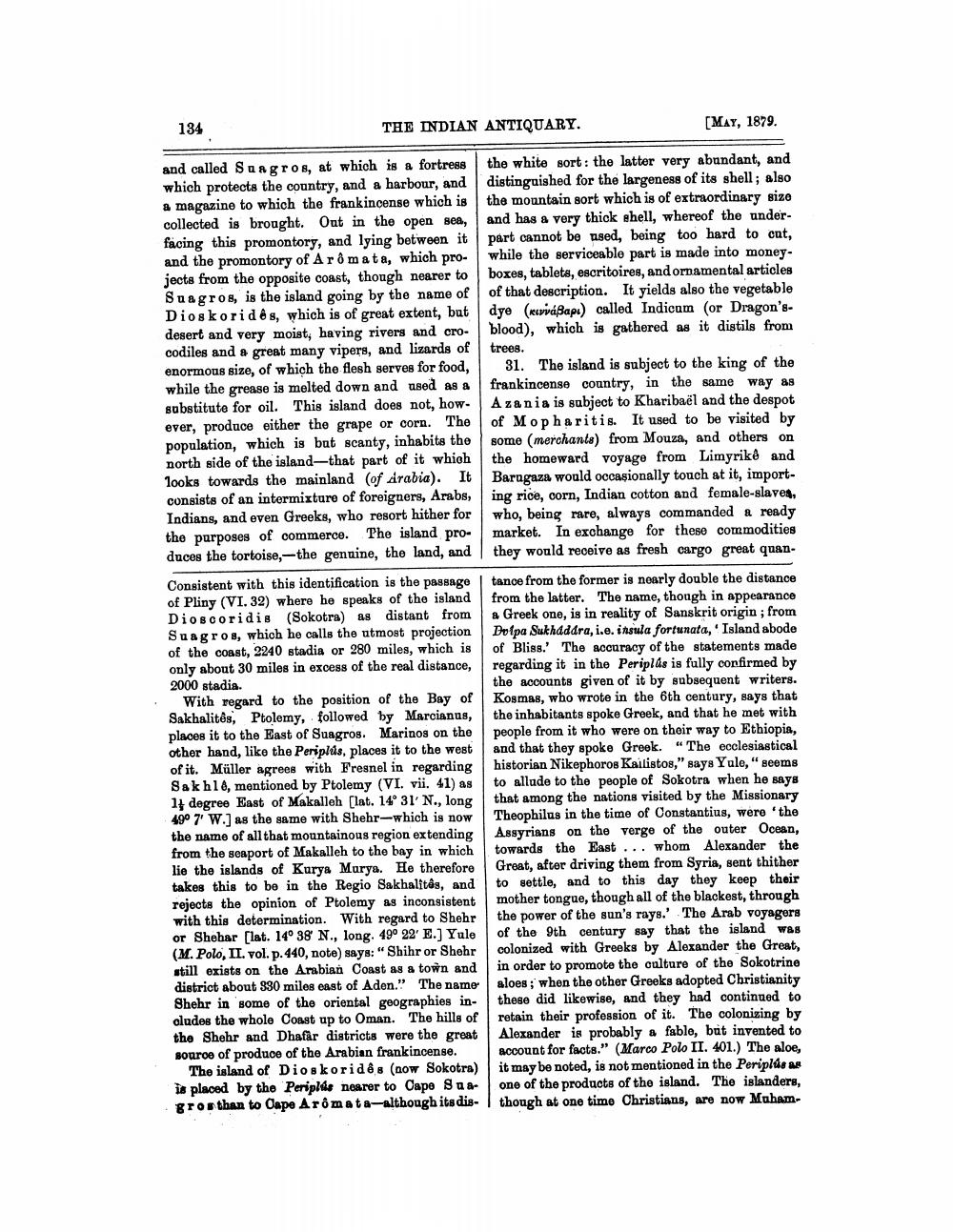________________
134
THE INDIAN ANTIQUARY.
[MAY, 1879.
and called Sangros, at which is a fortress the white sort: the latter very abandant, and which protects the country, and a harbour, and distinguished for the largeness of its shell; also a magazine to which the frankincense which is the mountain sort which is of extraordinary size collected is brought. Out in the open sea, and has a very thick shell, whereof the underfacing this promontory, and lying between it part cannot be used, being too hard to cut, and the promontory of A rô mata, which pro- while the serviceable part is made into money. jects from the opposite coast, though nearer to boxes, tablets, escritoires, and ornamental articles Suagros, is the island going by the name of of that description. It yields also the vegetable Dios korides, which is of great extent, but dye (kuvváßap.) called Indicum (or Dragon's. desert and very moist, having rivers and cro- blood), which is gathered as it distils from codiles and a great many vipers, and lizards of trees. enormous size, of which the flesh serves for food, 31. The island is subject to the king of the while the grease is melted down and used as a frankincense country, in the same way as substitute for oil. This island does not, how | Azania is subject to Kharibaël and the despot ever, produce either the grape or corn. The of Mopharitis. It used to be visited by population, which is but scanty, inhabite the some (merchants) from Mouza, and others on north side of the island-that part of it which the homeward voyage from Limyrik8 and looks towards the mainland (of Arabia). It Baragaza would occasionally touch at it, importconsists of an intermixture of foreigners, Arabs, ing rice, corn, Indian cotton and female-slaves, Indians, and even Greeks, who resort hither for who, being rare, always commanded a ready the purposes of commerce. The island pro- market. In exchange for these commodities duces the tortoise,-the genuine, the land, and they would receive as fresh cargo great quan
Consistent with this identification is the passage tance from the former is nearly double the distance of Pliny (VI. 32) where he speaks of the island from the latter. The name, though in appearance Dioscoridis (Sokotra) as distant from a Greek ono, is in reality of Sanskrit origin; from Suagros, which he calls the utmost projection Dolpa Sukhdddra, i.e.insula fortunata, Island abode of the coast, 2240 stadia or 280 miles, which is of Bliss.' The accuracy of the statements made only about 30 miles in excess of the real distance, regarding it in the Periplás is fully confirmed by 2000 stadia.
the accounts given of it by subsequent writers. With regard to the position of the Bay of Kosmas, who wrote in the 6th century, says that Sakhalitês, Ptolemy, followed by Marcianus, the inhabitants spoke Greek, and that he met with places it to the East of Suagros. Marinos on the people from it who were on their way to Ethiopia, other hand, like the Periplus, places it to the west and that they spoke Greek. "The ecclesiastical of it. Müller agrees with Fresnel in regarding historian Nikephoros Kailistos," says Yule," seems Sakh18, mentioned by Ptolemy (VI. vii. 41) as to allude to the people of Sokotra when he says 14 degree East of Makalleh (lat. 14° 31' N., long that among the nations visited by the Missionary 49° 7' W.] as the same with Shehr-which is now Theophilus in the time of Constantius, were the the name of all that mountainous region extending Assyrians on the verge of the outer Ocean, from the seaport of Makalleh to the bay in which towards the East ... whom Alexander the lie the islands of Kurya Marya. He therefore Great, after driving them from Syria, sent thither takes this to be in the Regio Sakhalitês, and to settle, and to this day they keep their rejects the opinion of Ptolemy as inconsistent mother tongue, though all of the blackest, through with this determination. With regard to Shehr the power of the sun's rays. The Arab voyagers or Shehar (lat. 14° 38' N., long. 49° 22' E.) Yule of the 9th century say that the island was (M. Polo, II. vol. p. 440, note) says: "Shihr or Shehr colonized with Greeks by Alexander the Great, still exists on the Arabian Coast as a town and in order to promote the calture of the Sokotrine district about 330 miles east of Adon." The name aloes; when the other Greeks adopted Christianity Shehr in some of the oriental geographies in these did likewise, and they had continued to aludes the whole Coast up to Oman. The hills of retain their profession of it. The colonizing by the Shehr and Dhafar districts were the great Alexander is probably a fable, but invented to Bouros of produce of the Arabian frankincense. account for facts." (Marco Polo II. 401.) The aloe,
The island of Dioskorid ê 8 (now Sokotra) it may be noted, is not mentioned in the Periplús as is placed by the Periple nearer to Cape Su & one of the products of the island. The islanders, gros than to Cape Aromata-although its dis- I though at one time Christians, are now Muham




